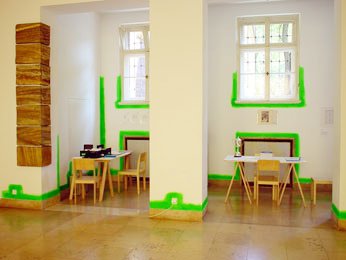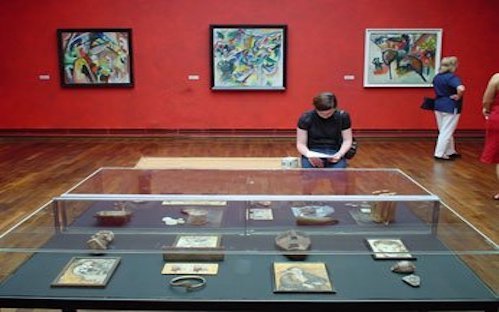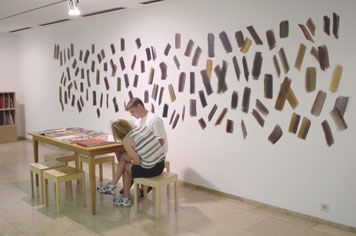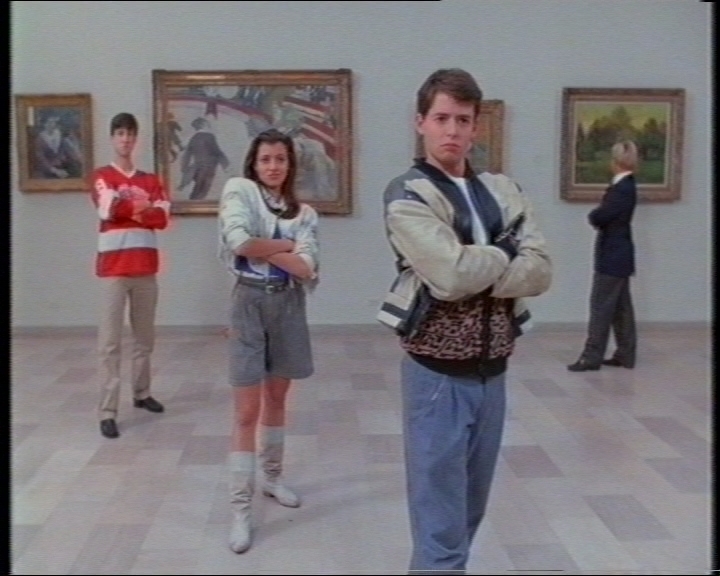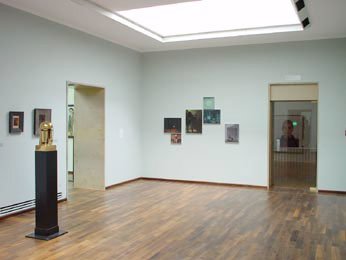The movement began with a scandal
'Am Anfang der Bewegung stand ein Skandal' (The movement began with a scandal) Lenbachhaus Museum
hosted by ...is a kunstraum project
22 June 2002 - 8 September 2002
Lenbachhaus Museum, Munich, Germany
Salon de Fleurus is an anonymous, group endeavor in the form of a long term exhibit whose subject is the collection of modern art assembled in Paris by Gertrude Stein (and her brother Leo). There is not an "official explanation" or "manifesto" that would explain to the visitors what this place is, what they are looking at and what might have been the intentions of its "authors". All interpretations (statements, articles) of this place so far have been external and they are all considered to be "legitimate". There is a place in Manhattan, New York that defies description. It is not a museum, gallery, residence or sacred space yet it suggests all of these. Its caretaker, Goran Djordevic, explains to visitors that the collection of African sculptures, antique curiosities and reproductions of modernist paintings constitutes a contemporary exhibition of anonymous artists. He reveals that reproductions relate to Gertrude Stein's art collection at her apartment on Rue de Fleurus, Paris. The place is a Proustian return to the realm of memory. It is an evocation of the modernist spirit of the early 20th century an imaginary restaging. At the Lenbachhaus Museum we encounter artefacts from the collection 'on tour'. Placed in the Blue Rider gallery these facsimiles relate to Kandinsky et al's search for original expression that included plundering non-European cultures. The objects and paintings are, themselves, a negation of authenticity, authorship and even historicity. The salon is a healthy antidote to the museum's demand for clear and easy boundaries. It recaptures something of a bygone experience of art-viewing, forging a critique of contemporary museum presentation imbued with a shifting modernist revisionism.
Year began with what seemed like a set of simple and achievable goals. The initial intention was to form an archive of artistic production, between 1st March 2000 and 28th February 2001, by inviting a different artist to contribute to each day of a consecutive three hundred and sixty fiev day period. The simple parameters- inviting artists to effect a piece of work on Royal College of Art headed notepaper, stamped with eachday's date- soon became unrealisable and the project began to drag, slowing almost to a halt. There were many reasons for this, foremost amongst them being a lack of time, sporadic and sometimes ineffectual organisation as well as occasional lapses into complacency or laziness. For these reasons Year is presented here as an incomplete project. Year began on 1st March 2000, and was intended to refer to Seth Sieglaub's March show, which was held at his New York gallery in 1969. Sieglaub invited thirty-one artists to exhibit separately on consecutive days through March. Unlike Year, Sieglaub successfully secured artist's contributions for each day of his projects duration. With March in mind Year may be considered, at least in terms of its numbers of contributors, as a more ambitious project. In hindsight, the volume of contibutors meant the very ambition of Year's administration seems ultimately to have been its undoing. So, what of the future for Year? The first twelve months are well and truly up and we have received roughly a third of the three hundred or so sheets we should have collated. It can either be seen as a failed project in light o fits predetermined goals, or its parameters can become a little more elastic, enabling it to transgress the austerity of its initial, limiting, conditions.
Mark Dickenson & Martin Clark
The museum still dominates the horizon of our material culture. It legitimates cultural form and expression. The institutional practices of selection, presentation and historiography deploy value that control and decipher our past. These governing practices, the ruling force of political and economic factors, reveal the museum as subject to the shifting associations of authority. They, also, exert and reflect specific contradictions in society. The museum's position as the most authoritative art institution may allow it to govern the construction of our present and also our hallucinatory future.
Liam Gillick, 'Inside now, we walk into a room with coca-cola coloured walls' 2002, courtesy, JRP Geneva
Liam Gillick attempts to paint true coca-cola brown in his neo-Platonic wallpainting "Inside now, we walked into a room with coca-cola walls". This proposed shift in environment leaves its test marks on the wall. The act reflects a reference to a passage in Gillick's book 'Discussion Island: Big Conference Centre', where one location has walls the colour of coca-cola. Perhaps, big brands, have almost acquired the aura of universal abstract truth: Coke, we know, is the 'real thing'.
Some artists have regarded the museum as obsolete. Museums were depicted as asylums. The works of art they housed appeared to be going through some kind of aesthetic convalescence. Separated from society they were politically lobotomised, inanimate invalids and ready for consumption. (Smithson) The disdain towards these institutions extended to the opinion that museums should be converted into recreational areas such as swimming pools or nightclubs. (Kaprow) Yet contemporary art's critique of the museum, even if reluctantly, still 'belongs' to the museum. These broadside attacks nevertheless recognised that the museum was, and still is, an arena in which power is secured, acknowledged, underwritten, disputed, confronted, lost and gained.
The museum has become more than the sum of its collection. Some institutions recognise that they are not unitary entities. By moving outside its four walls it has disseminated itself through various media into the broader social realm. Deploying a range of promotional activities, in competition with a burgeoning tertiary sector, the museum has extended its civic duty through publishing, corporate functions, websites, education, temporary exhibitions and café culture. The proliferation of these educational and promotional activities within museums has increased visitors. These audiences are a mixed constituency of people with varying interests, demands and expectancies from the museum. The museum's agenda has shifted from being merely a representative building towards a highly specialised space for communication, presentation and increasingly interpretation. This heightened interpretive role, through cooperation and communication, allows the institution to understand itself as a living organism. Clearly, it is within all these dispersed, interlinked interpretative structures that the discourse of art is fashioned and regulated, and into which some artists are seeking to intervene.
Sometimes these interventions can occur, an opportunity, an invitation, a moment of slippage or a temporary shift in focus where something unexpected is allowed to happen. People meet, discussions are held, ideas are exchanged and perhaps scandals are plotted. Movements gain momentum, plans are put into action, documents are written and intentions are displayed all in the name of 'what happens next'.
Am Anfang der Bewegung stand ein Skandal' begins with a fiction used as a diversion from the object attempting to promote something more solvent. The series of relations constructed allows the host museum to evolve heterogeneously and become more elastic. The scandal, perhaps, is a plot against the compliant filling of gallery space and the time frames that currently shape the life of institutions. Instead of bolstering exhibition routines, which limit certain practices, emotions and activities the project introduces different narratives and rhythms. Volker Eichelmann, Jonathon Faiers and Roland Rust reflect on this scenario and the social status of the museum via popular culture. 'Do you really want it that much?- More' is a crash-edited montage of the fleeting visits Hollywood film pays to the museum. Studying these sequences in juxtaposition we accumulate characteristics of how the museum is represented within fiction. The museum as a place of order and clarity is rendered chaotic and obscure open to a broad range of emotions: love, jealousy, melancholy, loss, happiness… The municipal formality of the gallery becomes a site for clandestine meetings, scandal, crime, action, daring theft, murder, forgery and corporate parties. The result is suggestive that, perhaps, the fictional representation of the museum can inform the organisation, running and our behaviour within the real institutions themselves.
The museum as a site for corporate play was previously the domain of the chairman's wife. Now through the emerging influence of promotion and association, the museum has become a more formidable culture broker. It is here we find the Szuper Gallery. Artists are seemingly involved at boardroom level. 'Good Morning Mr. Bloomberg' unveils a business deal, recorded on video, which is being celebrated between the artists and collectors. The camera focuses on gestures, ritual actions, artificial friendliness and smart dress. From these details, the viewer begins to sense that here the art world and economics are meeting in a lavish environment. The collection and acquisition of artworks, the clinching of a deal, all begin to display the overlap of culture and corporate economy. The artists here, perhaps, are entering into a partnership in which they are both complicit in their manipulation of symbols and representation. Is this the scandal? Or maybe they recognize that power lies within the process of mediation and contextualisation.
The image of complicity, cooperation and scheming within institutions is heightened through these imaginary covert meetings. A dominant culture is perhaps being manipulated, reinforced and sold through a series of soft power relations. Kaye Donachie's paintings delve into the formal and informal spaces where such decisions are made. They are bound within conspiratorial origins where agreements are made. Freemasonry underpins the original formations of bodies such as the museum and artistic movements that may reveal its secret through the very fabric of its architecture. Liam Gillick, similarly, recounts the story about a 'Winter School' set up in Kassel in 1971 before Documenta V in order to challenge the structure of expansive international exhibitions. There was no record of this meeting, no record of the school. Gillick imagines the scenario, the creation of an alternative structure, to place action into action, a projection into the future. Changing everything. He envisages discussions, agendas being drawn, disputes, reorganisation of crises and reclamation of the near future through an understanding of the middle ground. Of course, this is all presupposition, with no records filed, no evidence of the school’s activities, Documenta continues pretty much as it began.
From within these fictions what is becoming clear is that artists, their work and practices exist and are claimed under the banner of a larger economy of culture. Anfang der Bewegung stand ein Skandal' sketches the museum as an active arena. It incorporates practices that are interested in working alongside all of the institutions that manipulate the exchange of values between people and things. Essentially, taking Action. At times their activities are a search resistant to and therefore reclaimable from the dominant culture. Collaborative enterprises engineer a state of affairs or new constellations that are at once contradictory and apposite. Shifting between disparate venues, subjects, and forms of engagement there is no object, text or image held in higher esteem than the other. Allied variously to institutional critique, activist and political documentary traditions as well as post-studio, site-sensitive or public activities, these practices, do not necessarily share a thematic, ideological or procedural basis. What they do seem to share is the fact that they all involve a concern with asserting a material and political relation of affect with their social context. In each of these examples, shared communal and functional space is created as the literal location of (and means for) the artwork's realisation.
The exhibition is revealed as just one way amongst many of working with and letting art exist. Within 'Am Anfang der Bewegung stand ein Skandal' the distinctions between the production and reception of art are blurred. From the disruptive forces of a scrum of people or the personal museology of disparate possessions to soliciting functions for objects found on album covers. The networks of relationships are teased out to reveal a common currency that is socially and politically engaged.
The project ultimately seeks to piggyback the museum temporarily. From this perspective, it is not breaking away from the recent methodology and ethics of the museum. On the contrary, it opposes unquestioning mainstream museology, which too often reduces the political, emotional and active potential of art. Cementing itself sensitively within the host institution it co-exists and reshapes the experience of visiting the museum. The fluency of collaboration, not only in the projects contained within the show but between the exhibition and its host is both experimental and progressive.
Alun Rowlands & Susanne Clausen
Volker Eichelmann, Jonathon Faiers and Roland Rust reflect on the social status of the museum via popular culture. 'Do you really want it that much?- More' is a crash edited montage of the fleeting visits Hollywood film pays to the museum. Studying these sequences in juxtaposition we accumulate characteristics of how the museum is represented within fiction. The museum as a place of order and clarity is rendered chaotic and obscure open to a broad range of emotions: love, jealousy, melancholy, loss, happiness... The municipal formality of the gallery becomes a site for clandestine meetings, scandal, crime, action, daring theft, murder, forgery and corporate parties. The result is suggestive that, perhaps, the fictional representation of the museum can inform the organisation, running and our behaviour within the real institutions themselves.
How are art spaces projected in mainstream cinema? What does cinema want to tell us about the function of these spaces? Why does the cinematic representation of museums and galleries differ so much from the real? The video-sampler ‘Do you really want it that much ? … More!’ explores manifestations of art spaces as sites of sex, crime, comedy, and corporate play among others. This sampler produces a network of recurring themes and transformations that challenges established notions of museum and gallery going.
How is it that James Stewart gets a free catalogue?
Why does Clifton Webb regard something as ‘stiff as a sculpture’ not worth collecting?
How can a Jackson Pollock fuck up Woody Allen’s date?
Will Pepe le Pew ever catch his ‘object of art’?
In ‘heist’ movies such as ‘How To Steal A Million’ the museum is presented as an impregnable glittering fortress only to be reduced to a self-service shop window for the master criminal’s picking. These films subvert the museum’s function as custodian of the priceless cultural artefact. Does the sanctified space of the museum provide the perfect setting for anti-social behaviour only on film?
In many films the love of art is intermingled with the love of flesh. As in ‘Pleasure Seekers’ art spaces seem to provide the perfect stalking ground for sexual predators stimulated by the act of looking. With art spaces transformed into meeting places does the love of the object and the love object become irretrievably blurred?
Does Audrey Hepburn ‘really want it that much ? …More!’
Artlab//
Alexander Brener & Barbara Schurz//
Martin Clark & Mark Dickenson//
Eichelmann, Faeirs & Rust//
everything Editorial//
Flatpack 001//
Liam Gillick//
Inventory//
Daniela Johnson Co.//
Pawlo Kerestey//
Elizabeth Price//
Salon de Fleurus//
Tilo Schulz//
Szuper Gallery//
Mark Titchner//
Markus Vater//
Christopher Warmington//
'Good Morning Mr. Bloomberg' by Szuper Gallery unveils a business deal, recorded on video, which is being celebrated between the artists and collector. The camera focuses on gestures, ritual actions, artificial friendliness and smart dress. From these details the viewer begins to sense that here the art world and economics are meeting in a lavish environment. The collection and acquisition of art works, the clinching of a deal, all begin to display the overlap of culture and corporate economy. The artists here, perhaps, are entering into a partnership in which they are both complicit in their manipulation of symbols and representation.
Kaye Donachie's paintings are concerned with exploring spaces that reveal hidden or coercive power structures. From within the architecture and sense of place the ordered, secret, ritualistic elements reveal themselves as a web of signs. As part of 'The movement began with a scandal' Donachie has produced new paintings whose source reflect the historiography of the Lenbachhaus Museum and the Blue Rider. They depict the spaces and places where the Blue Rider artists met, worked, collaborated. They display the structures of a series of relations where decisions were made, manifestos written, progress made.
Donachie's work is suggestive of a form of patriarchal freemasonry behind these groups. Kandinsky used to tell the story of his enlightenment and movement towards abstraction. On a twighlight evening he visited his studio where he saw one of his figurative paintings lit by moonlight revealing itself as an abstract form. This experience mimics the Masonic ceremony where the initiate moves from darkness to light. Donachie depicts Kandinsky and Klee in a double handshake that is a restaging of Schiller and Goethe's act of kinship. The paintings appear as mediated backdrops to some absent secret narrative that are revealed through the fabric of their respective gestures and architecture.
Flatpack001, Presence: Cultural Excavation No.5
The Object' first appeared on the cover of Led Zepplin's 'Presence' album in 1976.
A family sit around a table contemplating a black silhouette before them. On the reverse of the album sleeve a scoolteacher is seen using 'The Object' as a teaching aid. Reminiscent of many forms the silhouette appears loaded with symbolic value.
Designed by the now defunct Hypnosis, 'The Object' has been described by its creators as representing 'any object within a community that everyone is perfeclty at home with.' An object without explicit function, Flatpack 001 wish to reveal possible meanings for its existence. We are approaching a number of people to ascribe a 'function' and give meaning to the object.


